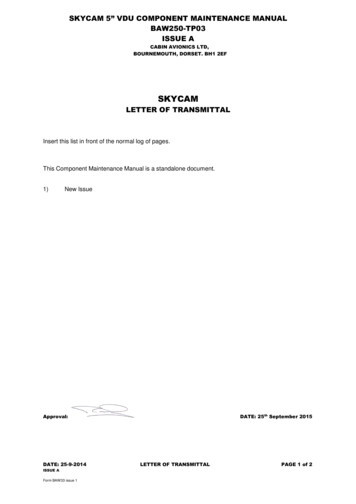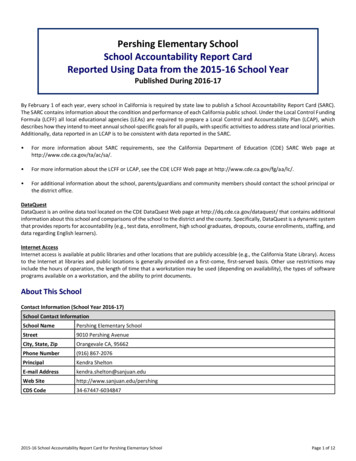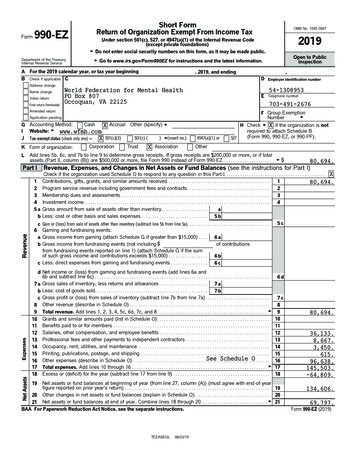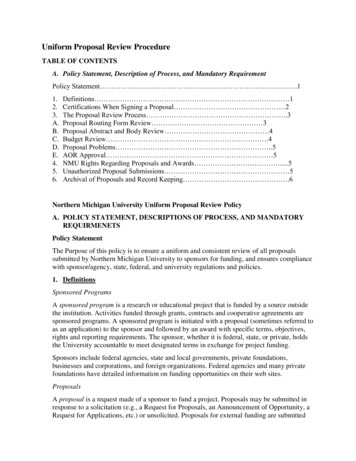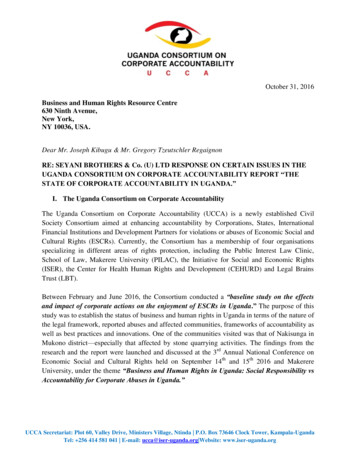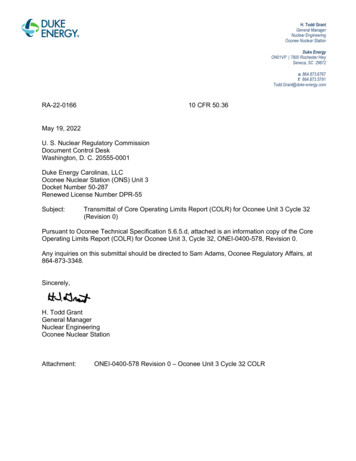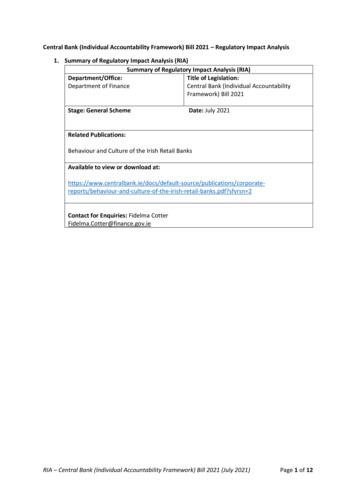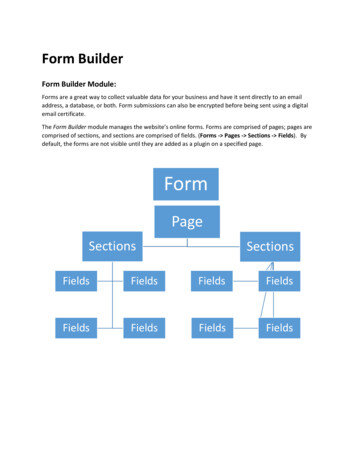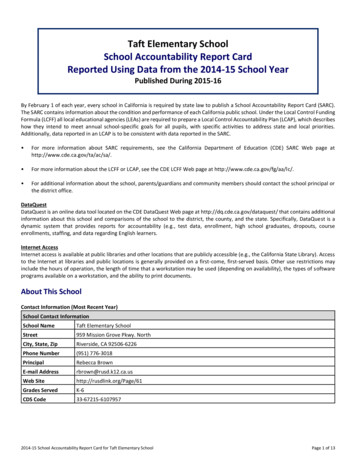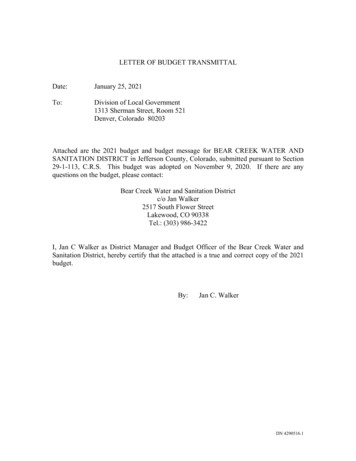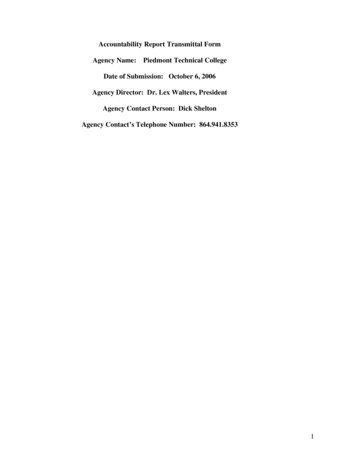
Transcription
Accountability Report Transmittal FormAgency Name:Piedmont Technical CollegeDate of Submission: October 6, 2006Agency Director: Dr. Lex Walters, PresidentAgency Contact Person: Dick SheltonAgency Contact’s Telephone Number: 864.941.83531
2
The Malcolm Baldrige Accountability ReportPiedmont Technical CollegeFY 2005-2006Section I: Executive SummaryI.1 Organization’s Stated Purpose, mission and valuesPiedmont Technical College, a member of the South Carolina Technical and ComprehensiveEducation system, is a public comprehensive two-year post-secondary institution. Piedmontcontributes to the economic growth and development of the largest and most diverse region ofthe technical college system, Abbeville, Edgefield, Greenwood, Laurens, McCormick,Newberry, and Saluda counties and to the state. The college responds to the academic, training,and public service needs of the community through excellence in teaching and educationalservices. Piedmont has an open admissions policy and annually enrolls approximately 4,500 to5,500-credit students. The college provides quality educational opportunities and accessibilityfor individuals with diverse backgrounds and ability levels to acquire the knowledge and skillsfor employment or the maintenance of employment in engineering technology, industrialtechnology, business, health, or public service or for transfer to senior colleges and universities.In addition to teaching technical skills, Piedmont provides graduates competencies in written andoral communication, information processing, mathematics, problem solving, interpersonal skills,and lifelong learning opportunities for residents within the service region.The college offers the following programs utilizing state-of-the-art technologies:Associate degrees in vocational, technical, and occupational areas and university transfer;vocational, technical and occupational diplomas and certificates; developmental educationprograms and courses preparing individuals to take the General Education Development Test,custom-designed Continuing Education training programs for business, industry, and facilitiesfor the Special Schools program to train potential employees for new and expandingmanufacturing companies; and Student Development programs which provide academic, careerand individual support.Piedmont Technical College pursues its mission based on the fundamental Values andBeliefs that:Learning is a diverse and fundamental need for all residents of the seven county areas;Excellence is a process inherent to the college within instruction, support services,administration, and resource allocation.Accessibility and Affordability to higher education by all who have a desire to learn is crucial forcontinuous growth and improvement by communities and individuals.Quality and Innovation is fundamental to the continuous improvement of instruction, learningopportunities, support services, and management practices.Community partnerships with other educational entities, industries, and businesses are crucial forquality of life and economic development.(Reaffirmed by The Area Commission, April 18, 2006.)3
I.2 Major Achievements from past year:New Programs Await PTC Students This FallPiedmont Technical College will broaden its academic options this fall to include a newassociate’s degree in horticulture and five new certificate programs in the fields of computeraided drafting (CAD), emergency medical technician (EMT), entrepreneurship, massage therapyand pottery.Automotive Technology Program at PTC Earns National CertificationThe Automotive Technology program at Piedmont Technical College hasreceived reaccredidation by the National Automotive TechniciansEducation Foundation, Inc. (NATEF) and the National Institute for Automotive ServiceExcellence (ASE). A great achievement, the recognition includes a series of rigorous evaluationsby NATEF using nationally accepted standards of excellence in areas such as instruction,facilities and equipment.Agreement between PTC and Edgefield Saves Students Time andMoneyAn articulation agreement signed between Piedmont Technical College andEdgefield School District will allow high school students in the horticulturecurriculum to earn college credit while completing courses at the highschool level. By not having to repeat similar courses at the college level, the agreement savesstudents both time and money.Agreement between PTC and District 50 Saves Students Time andMoneyDr. Lex Walters, left, president of Piedmont Technical College, looks on asDr. William Steed, superintendent of Greenwood School District 50, signsan articulation agreement that allows high school students in the machinetool and carpentry curricula to earn college credit while completing courses at the high schoollevel. By not having to repeat similar courses at the college level, the agreement saves studentsboth time and money.4
Piedmont Tech Hosts Free Community Careers WorkshopPiedmont Technical College, along with the Upper Savannah WorkforceSystem, will host free Community Careers Workshop on the Lex WaltersCampus in Greenwood. The three-hour session consists of a series of short,informational workshops for individuals considering returning to college to improve theiremployment opportunities. Participants will hear about training programs, educationalopportunities, available financial assistance and job outlooks.Piedmont Tech Recognizes First Class of Patient Care TechniciansThe first class of Patient Care Technicians at Piedmont Technical Collegewas recently recognized at a luncheon. Joining the students were theirinstructors and several nursing directors from Self Regional Healthcare.New Degree and Agreement Benefits PTC Horticulture StudentsA new associate’s degree and 2 2 articulation agreement will providestudents in Piedmont Technical College’s horticulture program a moreseamless transition to four-year degrees. The new degree joins the college’sstrong landscape management program, a one-year certificate.Center for Creative Economies Slated for Grand OpeningThe center, currently under construction in a former cotton warehouse, willfeature a traditional Edgefield groundhog kiln (built in the side of a hillcovered by dirt), along with modern gas and electric kilns. Eventually, thecenter will also serve as an “arts incubator” where craftsman can shareworkspace and expenses until they are self-sufficient to grow their ownbusiness. In the future, they also plan to offer other craft programs such as jewelry making,glasswork and weaving all based on the Edgefield Pottery Tradition. For more information onthe pottery program, contact the center at (803) 637-5388 or visit www.ptc.edu/pottery.5
Dual Enrollment Allows High School Students a Jump Start onCollegeMore than 340 juniors and seniors at 16 area high schools and careercenters have the right idea about college: why wait? These students areall taking advantage of the dual enrollment program at Piedmont Technical College this spring.The program gives high school juniors and seniors the opportunity to earn college credit whilestill enrolled in high school.Dual credit courses allow students to fulfill high school diploma requirements while earningcollege credit simultaneously. Early Admission courses allow juniors and seniors to take coursesbeyond those required in high school.I.3 Key Strategic Goals for the present and future years: Strengthen the skills of individuals to further enhance their economic development. Establish collaborative responsive partnerships with industry, community and othereducational entities for designing programs/services that empower learning and skilldevelopment. Expand Instructional technology to diversify the educational market place to the globalregion. Be the college of choice for all individuals in the service regionI.4 Opportunities and Barriers that may affect the success of the organization: The decreasing amount of state funding in relation to increased enrollments across thecollege over the years will drive tuition increases further and further. The uncertainty within lottery funding to insure the two year college student has equaland affordable opportunities for a post secondary education. The increasing numbers of enrolled high school students participating in “dualenrollment” programs presents a positive outlook for the futureeducational and economic development within the serviceregion. The rapid expansion (enrollment increases of 200% over fiveyear period) of health service programs with the region andstate place barriers for facilities, recruitment of Master DegreeNursing instructors, and instructors within all health programs.I.5 How improvements are made based upon the Accountability report: Results of measurable operational tactics assist the college in determining existing andfuture needs within the service region. Assessment of students and industry leads to the development of new academic programsand support services.6
Section II: Organization ProfileII.1 Main educational programs, offerings services and methods of delivery.The college provides direct support for students requiring educational readinessassistance through the following processes:¾ Student Support Courses for college skills and college adjustment¾ Developmental Education: prescriptive procedures for students inreading, English and Mathematics¾ Bridge/Transitional Courses designed for students entering mainstreamacademic curricula.Academic programs are delivered by traditional lecture formats, Distance Learning, WeekendCollege, hybrid courses (traditional merged with on line). Refer to 6.2 for table of supportservices available to students.Academic Offerings: (Please refer to the last page of this document for a sample academicProfile. Page 50)AGRICULTUREAssociate DegreeMajor in Horticulture New for fall 2006!2 2 Transfer Programs with Clemson University new for fall 2006!Horticulture / Turf grass (Associate in Science)Certificate ProgramHorticulture Landscape ManagementARTS & SCIENCEAssociate's DegreesAssociate of ArtsAssociate of ScienceGeneral Studies CertificateBUSINESSAssociate's DegreesAssociate in BusinessAssociate in Business (Funeral Services)Associate in Business (Office SystemsTechnology)Associate in Computer TechnologyDiploma ProgramsAutomated Office DiplomaCertificate ProgramsAccounting CertificateAdvertising Design CertificateCisco Computer Networking CertificateDesktop Publishing CertificateEntrepreneurship Certificate NEW FORFALL 2006!Funeral Services Education CertificateIllustration CertificateInternet Certificate NEW FOR FALL 2006!Interior Design CertificatePC Technician Certificate (REVISED)Microcomputer Software Specialist CertificateOffice Technician CertificatePhotography CertificateProfessional Clay Certificate NEW FORFALL 2006 IN EDGEFIELD!Word Processing Certificate7
ENGINEERING TECHNOLOGYCertificate ProgramsComputer Aided Drafting and DesignNew for fall 2006!Associate's DegreesPiedmont Technical College offers theAssociate's Degree in EngineeringTechnology with the following majors:Major in Electronic Engineering TechnologyMajor in Engineering Graphics TechnologyMajor in General Engineering TechnologyMajor in Mechanical Engineering TechnologyHEALTH SCIENCESAssociate's DegreesPiedmont Technical College offers theAssociate's Degree in Health Science with thefollowing majors:Major in NursingAdvanced Placement Nursing ProgramMajor in Radio logic TechnologyMajor in Respiratory CareDiploma ProgramsMedical Assisting DiplomaPharmacy Technician DiplomaPractical Nursing DiplomaSurgical Technology DiplomaCertificate ProgramsBasic Emergency Medical TechnicianDental Hygiene CertificateGeneral Health Science CertificateHealth Information Management CertificateMassage Therapy Certificate NEWMedical Coding & Billing Certificate NEW!Medical Laboratory Technology CertificateOccupational Therapy Assistant CertificatePatient Care Technician Certificate NEW!Phlebotomy Technician CertificatePhysical Therapy Assistant CertificateINDUSTRIAL TECHNOLOGYAssociate's DegreesPiedmont Technical College offers theAssociate's Degree in Industrial Technologywith the following majors:Major in Automotive TechnologyMajor in Building Construction TechnologyMajor in Heating, Ventilation & AirConditioning TechnologyMajor in Industrial Electronics TechnologyMajor in Machine Tool TechnologyDiploma ProgramsMachine Tool DiplomaWelding DiplomaINDUSTRIAL TECHNOLOGYDiploma ProgramsMachine Tool DiplomaWelding DiplomaCertificate ProgramsCarpentry CertificateComputerized Numerical Control CertificateConstruction Management CertificateElectrical Maintenance Technician CertificateHeating Fundamentals CertificateIndustrial Maintenance Mechanics CertificateJourneyman Welding CertificateMachine Tool Operator CertificateRefrigeration Applications CertificateOCCUPATIONAL TECHNOLOGYAssociate's DegreesPiedmont Technical College offers theAssociate's Degree in OccupationalTechnology with the following majors:Major in General TechnologyMajor in Vocational Technical EducationPUBLIC SERVICEAssociate's DegreesPiedmont Technical College offers theAssociate's Degree in Public Service with thefollowing majors:Major in Criminal JusticeMajor in Early Care and EducationMajor in Human ServicesCertificate ProgramsEarly Childhood DevelopmentCertificateInfant Toddler Certificate NEW!8
Primary methods of delivery include but are not limited to:¾¾¾¾¾¾¾Traditional Lecture formatsInternet CoursesWeekend CollegeClinical/Laboratory experiencesPiedmont Educational Network (PEN)Field/Co-op Work ExperiencesIndependent StudyII.2 Key student segments, requirements and expectations.Piedmont Technical College is an open door state supported college serving the largest region of South Carolina ofany of it’s sister technical institutions. With a primary Mission of economic development, the college activelyencourages students of all ages to develop their knowledge and skill base to insure educational opportunity and tofurther individual economic potential. The typical student at Piedmont is a direct mirror of the national trend in postsecondary education, a female student, in her mid twenties, married, working and enrolled at the college.II.3 Operation LocationsPiedmont Technical College serves the counties of Abbeville, Edgefield, Greenwood, Laurens, McCormick, Newberryand Saluda. Traditionally, Piedmont served these counties from Greenwood's Lex Walters Campus.In the 1990s, however, a major growth initiative provided for the construction of centers in the six outlying counties ofthe college's service area. For the first time, students in Abbeville, Edgefield, Laurens, McCormick, Newberry andSaluda could enjoy the convenience of a local campus where they could take courses and benefit from campusservices.II.4 Regulatory Environment under which the college prehensiveEducationThis organization administers to Piedmont Technical College and its 15 sister institutions. In addition toadministering to the college, the college also has a governing board, Area Commission. Recommended by theirrespective county councils or legislative delegations and appointed by the governor, commissioners serve for four-yearterms. They have responsibility for activities that fulfill legislative requirements "to make available and operateadequate facilities; provide for adequate facilities; and conduct a program of technical education."II.5 the Governance SystemServing the largest geographic area in the S.C. Technical College System, Piedmont’s governing board comprisesrepresentatives from each of seven supporting counties. That representation is based upon the number of studentsenrolled from each county, and the authority of the commission is mandated by Act 234 of the General Assembly ofthe State (May 24, 1963).In addition to reporting under the umbrella of the State Board for Technical and Comprehensive Education, thecollege adheres to the guidelines of the Southern Association of Colleges and Schools.9
II.6 Key Suppliers and PartnersOver 25 public and private High Schools in the service region.¾ Over 200 industry partners for credit and non credit training programs.¾ World wide partners with students participating thru on line course work.II.7 Key CompetitorsAny public, private or proprietary institution providing Associate Degrees, Diplomas, Certificates or specialized noncredit training within the seven county service regions.II.8 Principle Factors that determine competitive success:¾¾¾¾¾¾¾¾¾¾Student enrollmentGraduation ratesRetention ratesQuality programs and servicesAffordable student costQuality Faculty, staff and Administrators.Up to date FacilitiesInnovation for Programs and ServicesResponsiveness to the needs of the regionJob Placement of GraduatesII.9 Changes that significantly impact your competitive situation.¾ Uncertainty of funding from year to year, forces the colleges to increase costs for students.¾ Rapid expansion within the Health Industries force the college to expand services and programs without havingfunding support from the state to insure adequate up to date facilities and competent well trained faculty.¾ The changing work place to one of service and health related vocations encourage innovations and increasedprogram offerings.¾ Technology changes daily. The college must have access to technology to insure the Mission and Vision is potent.II.10 Performance Improvement Systems¾¾¾¾¾¾Academic program reviews are conducted yearly.Performance Funding Measures on all aspects of the college are viable measures for success.Institutional Effectiveness Measures are documented yearly.Programs requiring, or benefiting from, third party accreditation is sought after vigorously.Open enrollment centers are established to provide direct student/customer service assistance.The use of on line (Internet) programs and services provide the college with 24/7 assistance and delivery oftraining.II.11 Expenditures/Appropriations Chart (see page 15)II.12 Major Program Areas Chart (see page 17)10
II.13 Organizational ChartOrganizational Chart of Piedmont Technical College.Area CommissionAcademic AffairsAdmin/Bus ServicesCollegeStudent AffairsPresidentInstitutional AdvancementPTC FoundationInstitutional ResearchCollege Communications11
Section III: Senior Leadership, Governance and Social ResponsibilityIII.1 How do senior leaders develop and deploy their organization’s vision and values throughout the leadership system,to all faculty and staff, to key suppliers and partners, and to student stakeholders as appropriate? How do their personalactions reflect a commitment to the organizational values?Each year, the College Leadership Team composed of the college President, Institutional Officers and PresidentialDirect Reports collaborate with the college Area Commission and faculty and staff to adopt and review the vision andvalues of the college while supporting the college strategic goals. This process is verified and modified each year in acollege wide planning session that provides an opportunity for college employees and stakeholders to provide input andfeedback on initiatives. Final results are published in the college catalog, published on the college web site; published onthe student web site and reviewed each semester with the area commission. In Addition, bi monthly planning sessions areconducted by the leader ship team where objectives are reviewed and areas for priority action are identified. Eachmember of the Leadership Team conducts sessions with their direct reports to insure appraisal evaluations support thevision and values of the college. The Leadership Team implements strategies to incorporate employee developmentopportunities into each associate’s personal development plan/EPMS, scheduled employee meetings, departmentalmeetings and email messages.III.2 How do senior leaders promote and support an environment that fosters and requires legal and ethical behavior;and, fiscal, legal, and regulatory accountability? How are these monitored?The college President, along with the Executive Leadership Team, actively works to encourage and support aworking environment that focuses on the organizations’ internal and external customers. The college President andhis executive team continually focus on accountability. The recent trend of budget reductions and lower staterevenues has put an increased emphasis on accountability to ensure that all funds are expended in the mostefficient, goal-oriented manner. Senior leadership has in place a strong system of processes/directives that ensurethat fiscal, ethical, legal and regulatory accountability is emphasized at regularly scheduled meetings.III.3 How do senior leaders create a focus on action to accomplish the organization’s objectives, improve performanceand attain our vision?Senior leaders review performance of objectives that support the College’s strategic goals. These performanceobjectives are as well tied to the College President’ performance review as well as senior leaders’ EPMS reviews.Additionally, the College President and Director of Planning communicate with the Leadership Team and allcollege Personnel on a regular basis to review progress on priority issues. The Director Planning also meets withthe Leadership Team members to provide quarterly and annual reporting on progress of priority issues. Theseresults are then made available electronically to all faculty and staff.III.4 How do senior leaders create an environment for organizational, faculty, and staff learning?The college has institutional polices governing Professional and Staff Development. These include, but are notlimited to, development programs for credit and non credit level that will enhance and develop the individualprofessionally. Professional Development is encouraged and supported through the College Foundation andincorporated on individual EPMS reviews.III.5 How do Senior Leaders promote and personally participate in succession planning and the development of futureorganizational leaders?The college actively participates in the nomination and support of individual for local community based leadershiptraining programs; encourages and supports continued higher education for its personnel, and actively supportsyearly nomination of individuals to participate in the SCTCS Leadership Academy and the USC Graduate SchoolLeadership in Higher Education Certificate program.12
III.6 How do Senior Leaders communicate with, empower, and motivate all faculty and staff throughout theorganization? How do senior leaders take an active role in faculty and staff reward processes to reinforce highperformance throughout the organization?The key leadership of the college does not take the stance that motivation may be imposed but rather support alearning environment which encourages risk taking, creativity and innovation. To support these endeavorsprocesses are in place that provide individual recognition and team recognition during monthly faculty staffmeetings; innovation grant funding is available through the college Foundation to support the creative andinnovative practices; nominations by the leadership for faculty, staff and administrator of the year awards andnomination by key leaders for faculty and staff members as Presidential Medallion winners which are awarded bythe leadership during graduation ceremonies.III.7 How does your organization evaluate the performance of your senior leaders and the governance board/policymaking body? How do senior leaders use these performance reviews to improve their own leadership effectiveness andthat of the board and leadership system, as appropriate?The over riding issue are those objectives and goals which are driven by the Institutional Plan of the college. TheCollege President reviews performance of objectives that support the Institutional Plan, which in turn supports thegoals of the college president. These performance objectives are tied to the college president’s review as well asthe senior leaders’ EPMS reviews. Additionally, the college president as well as his leadership team communicateswith the college’s Area commission on a monthly basis to review progress on priority issues and call special workteam meeting with area commission members as needed. Each organizational office within the collegeincorporates performance reviews into the next year’s action plans. Senior leaders also utilize employeesuggestions to develop new ways to improve employee communications and performance. Based upon thereviews of leadership action plans goals and strategies for improvement are further built into the next yearsInstitutional Operational Plan and tied back to the senior leadership member’s EPMS review.III.8 How does your organization address and anticipate any adverse impacts of its program offerings, services, andoperation?What is the key compliance related processes, goals, and measures? (Actual results are available in Category 7)The overwhelming adverse impact upon programs, services and operation result in the inequities of funding overthe past ten years. The college has been forced to, out source areas of operations and support; limit class offerings;control curricular expansion; and structure on going objectives and goals to meet the realities of the irregularchanging funding patterns. Processes and measures are defined as internal reports which focus upon HC, FTE,Program quality/strength, Institutional Effectiveness and Performance Based Funding criteria.III.9 How do senior leaders actively support and strengthen the communities in which your organization operates? Areasof emphasis for organizational involvement and support, and how leaders, faculty and staff, and the organization’sstudents contribute to improving those communities?Senior leadership meet on regular basis with county council members, economic alliance teams, serve oncommunity boards; conduct media interviews (radio and television); speak to and become members of civic groups.Students through winning National scholarship competitions; participating and assisting with specialized camps forcommunity youth; building a home through BCT each year; volunteering time in assisted living facilities, day cares,hospitals etc; mentoring new students and potential new students and being models of success for economicimprovement. The function of “community” is directly supported in the Institutional Plan with the core values of thecollege, Through Communities:“The college is responsible for cultivating educational and socio-economic opportunities, primarily within the sevencounty service regions, while expanding its role in the global community.”13
Category 2: Strategic Planning2.1 What is your strategic Planning Process, including key participants, and how does it address:a.b.c.d.e.Your organization’s strengths, weaknesses, opportunities and threats.Financial, regulatory, and other potential risksShifts in technology, student and community demographics, markets, and competition.Long term organizational sustainability and organizational continuity in emergencies.Your ability to execute the Strategic Plan.PolicyIt is the policy of Piedmont Technical College to develop an annual management plan which includes institutional goals,strategies, and tactics for work teams within the college.Planning Loop: Mission StatementStrategicGoalsOutcomesPerformance Criteria(Strategies)Budget AllocationPerformance Measures(Tactics)Individual and organizational performance is enhanced when each work team knows with some precision what it isexpected to accomplish. The duties of each work team are best understood when presented as a series of tactics to beachieved in a given period of time. Such understanding supports higher managerial performance by focusing the activitiesof each work team toward the achieving of tactics which are defined in the Institutional Plan. The work team’s success ismeasured more accurately by performance in achieving those tactics than by attempting to assess nebulous personalcharacteristics. In such a system of management,Individuals may work with relative independence, their efforts guided by the Institutional Plan. This is conducive tomaximizing satisfaction derived form personal accomplishment and facilitating professional development. The workteam leaders play essentially a supporting role in helping subordinates accomplish their tactics. Practices to carry out thisphilosophy are not appendages to any pre-existing system of management. The installation of this system of managementis a developmental project which can proceed toward full operational status at the pace at which it is understood andaccepted by all concerned.All supervisors or others designated by the Institutional Officers as being responsible for work team management shouldobserve the practices and procedures as described above. The tactics established for each work team shall be in support ofoverall divisional and/or institutional tactics. The success of each work team will be measured by the degree to which itshall accomplish assigned tactics insofar as this realization is within the team’s ability to control. Institutional strategies14
and tactics will be developed each year to move the institution towards accomplishment of its goals as approved by theArea Commission.During the period of February 15 to July 1 of each year, modifications of the college Goals, Mission, Values, and Beliefswill be adapted as needed by an administrative planning team and the college’s Area Commission. This final documentwill be compiled by the Director of Institutional Planning and reviewed by the Institutional Officers (Work TeamLeaders). Prior to final completion and approval, each operational tactic will be reviewed by the Vice President ofAdministrative Services to ensure adequate funding is available for implementation of each tactic. The final documentwill be approved by the colleg
Agency Contact Person: Dick Shelton Agency Contact's Telephone Number: 864.941.8353 . 2. 3 The Malcolm Baldrige Accountability Report Piedmont Technical College FY 2005-2006 Section I: Executive Summary I.1 Organization's Stated Purpose, mission and values Piedmont Technical College, a member of the South Carolina Technical and Comprehensive Education system, is a public comprehensive two .
